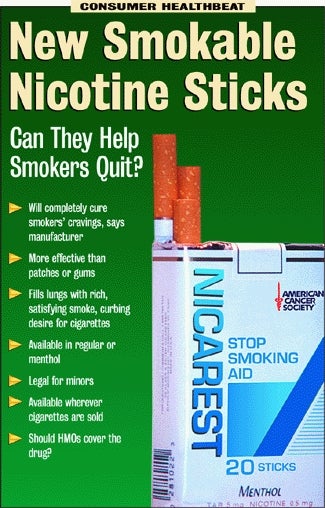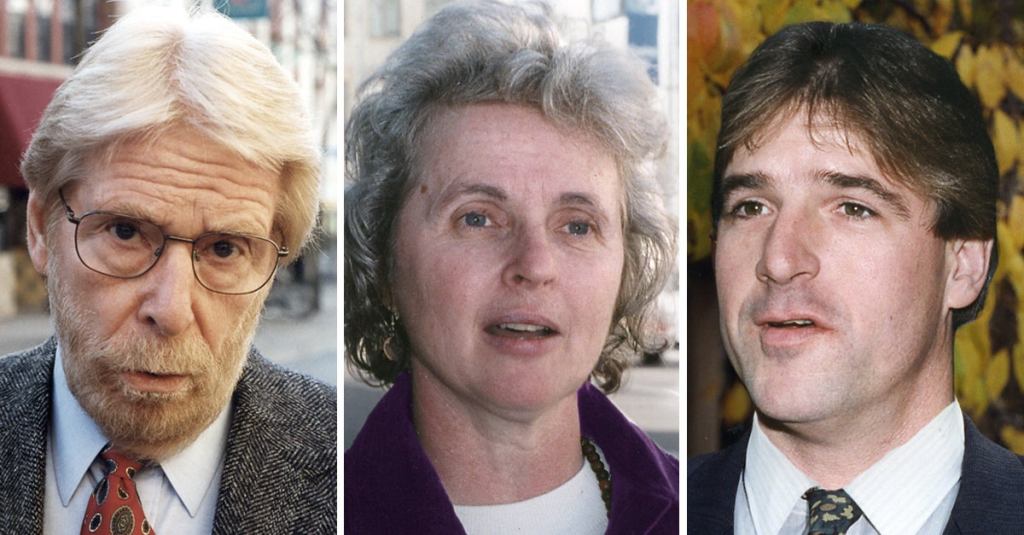LOUISVILLE, KY—When Adrienne Lundy, 37, a pack-a-day smoker from Louisville, was diagnosed last November with a malignant tumor on her right arm, she knew she had to kick the habit. But like many longtime smokers, Lundy found quitting to be much harder than expected.
“Gums, patches, hypnosis—you name it, I tried it,” said Lundy, a Marlboro smoker for 21 years. “Nothing worked—until I my doctor told me about a new product called Nicarest.”
Lundy is not alone. To date, more than two million American smokers have tried Nicarest, a specially treated nicotine stick which, when lit and inhaled, is said to completely curb a person’s craving for cigarettes. Manufactured by QuitLabs, a Winston-Salem, NC, pharmaceutical company, Nicarest is made of processed tobacco by-products and medicated with carefully calculated doses of nicotine and antibiotic “tar.” Nicarest has won the endorsement of the Surgeon General, American Cancer Society and American Medical Association, and has quickly become the most popular stop-smoking aid on the market.
“Whenever I get the urge for a cigarette, I just head for Nicarest Country instead,” said Doug Luedtke, 44, a Wichita Falls, TX, forklift operator who said his smoking was “completely out of control.”
“Unlike patches and gums, Nicarest duplicates the sensation of actually smoking a cigarette, filling my lungs with rich, satisfying smoke,” he said. “And at just $3.50 for a 20-stick pack, it’s not much more expensive than cigarettes.”
“Nicarest may have saved my life,” said Lundy, playing with her newborn daughter in the yard of her home, her cigarette cravings held firmly in check by the freshly lit nicotine cylinder wedged in the corner of her mouth. “I haven’t touched a Marlboro since discovering Nicarest. Not one.”
QuitLabs CEO Charles Randle, the tobacco pharmacologist who developed the “combustible medicated habit-cessation nicotine-delivery ampule,” said he came up with the idea for the product while working for Philip Morris in the late ’80s.

“From my work at Philip Morris, I was familiar with the process of transferring nicotine to the human lung via an oxidized vegetable-matter medium,” Randle said. “From there, it was a simple matter of applying that know-how, not to smokers, but to smokers who wanted to quit.”
“By doubling the nicotine dosage in Nicarest,” Randle continued, “we removed any biochemical reason for a smoker to fall back on cigarette dependency. But smokers aren’t just accustomed to nicotine. They’re also accustomed to the visual, tactile, oral, and even psychological sensations of having a small lit cylinder of tobacco in their mouths. That’s what Nicarest gives them. That’s our secret.”
Apparently, the strategy has worked. Though it has been on the market for less than two months, Nicarest—available in Regular, Filters, Lights, Ultra Lights, Slims and Menthol—already outsells all other stop-smoking aids combined. And on June 25, RJR Nabisco purchased a controlling interest in Nicarest, Inc., making Randle a very rich man.
Sales continue to skyrocket as increasing numbers of smokers abandon their cigarettes for Nicarest. The long-familiar “smokers’ corners” outside schools and businesses are rapidly disappearing, as smokers calm their cravings with Nicarest wherever they may be, since Nicarests are permitted in areas off-limits to regular smokers.
“Whenever and wherever I get the urge—at the movies, at work, in a restaurant—I can inhale Nicarest’s robust, satisfying medication and calm my body’s urges,” said Cynthia Mecklenburg of East Meadow, NY, a two-packs-a-day Nicarest user who learned of the product from a recent television advertisement. “And it’s the one stop-smoking aid that’s alive with pleasure.”
“My baby’s not going to grow up in a house filled with harmful cigarette smoke,” said Lundy, who plans to start her daughter on Nicarests as a preventative measure as soon as she turns 16, the age at which Lundy started to smoke. “Her mother is going to be a Nicarest user. When she’s older, she’ll realize just how important that difference really is.”







